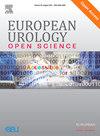Characterisation of Multiparametric Magnetic Resonance Imaging of the Prostate in Younger Men with Normal Prostate-specific Antigen Within the PROBASE Study
IF 4.5
3区 医学
Q1 UROLOGY & NEPHROLOGY
引用次数: 0
Abstract
Background and objective
Multiparametric magnetic resonance imaging (mpMRI) has emerged as an essential tool for the diagnosis of prostate cancer (PC). However, the right time to start screening for PC is not defined. This study aims to analyse mpMRI in young men at the age of 47–52 yr with normal prostate-specific antigen (PSA) values of ≤3 ng/ml.
Methods
In this prospective analysis, consecutive men undergoing PSA screening with PSA levels below 3 ng/ml were offered mpMRI as part of the PROBASE study. Magnetic resonance imaging (MRI) parameters were assessed, and the findings included changes in T2-weighted (T2w) images, apparent diffusion coefficient (ADC), and dynamic contrast enhancement (DCE). Prostate Imaging Reporting and Data System (PI-RADS) category 4 or 5 would indicate a biopsy. The Kruskal-Wallis test was used to compare the ADC and PSA values across different PI-RADS categories, and the Spearman rho test was used to examine the relationship between T2w changes and PSA values for PI-RADS categories.
Key findings and limitations
Forty-seven men were included (median PSA 1.22 ng/ml; interquartile range 0.47–1.79 ng/ml) between September 2021 and March 2022. High-quality MRI (median Prostate Imaging Quality [PI-QUAL] score 5) resulted in a median PI-RADS classification of 2 with low prostate volumes (median 27 ml). PI-RADS 3 classification occurred in 45% (median PSA 1.51 ng/ml). No score higher than PI-RADS 3 was observed. After 2-yr follow-up, no PC was reported in these men. For the peripheral zone (PZ), diffuse T2w changes were present in 81%. Focal and accentuated T2w changes were detected in 11% and 40%, respectively. DCE of the PZ was observed partially and severely in 53% and 17%, respectively. Limitations of this study are its small sample size, which provides more uncertainty regarding whether we were able to find reliable estimates for the outcomes explored in this study, the single-centre design, and the limited histopathological proof of nonmalignant cases.
Conclusions and clinical implications
In younger men with normal PSA levels, clinically significant PC was not detected on MRI. When using the PI-RADS classification, extensive T2w changes and DCE led to a classification in category 3, an observation that we made frequently in this cohort. The MRI appearance in these cases seem more likely to be age specific or inflammatory due to not PC-specific ADC values, but nonetheless PC cannot be excluded safely.
Patient summary
Magnetic resonance imaging characteristics in young healthy men with normal prostate-specific antigen levels are, in particular, diffuse T2-weighted hypointensity and dynamic contrast enhancement of the peripheral zone. These seem to be more likely age specific or inflammatory, but resulted in a higher proportion of patients with Prostate Imaging Reporting and Data System 3 classification.
在PROBASE研究中,前列腺特异性抗原正常的年轻男性前列腺多参数磁共振成像特征
背景与目的多参数磁共振成像(mpMRI)已成为诊断前列腺癌(PC)的重要工具。然而,开始筛查PC的正确时间尚未确定。本研究旨在分析47-52岁前列腺特异性抗原(PSA)正常值≤3ng /ml的年轻男性的mpMRI。方法在这项前瞻性分析中,连续接受PSA筛查且PSA水平低于3ng /ml的男性接受mpMRI检查,作为PROBASE研究的一部分。评估磁共振成像(MRI)参数,结果包括t2加权(T2w)图像、表观扩散系数(ADC)和动态对比度增强(DCE)的变化。前列腺影像报告和数据系统(PI-RADS)分类4或5表示活检。采用Kruskal-Wallis检验比较不同PI-RADS类别的ADC和PSA值,采用Spearman rho检验检验PI-RADS类别的T2w变化与PSA值之间的关系。主要发现和局限性纳入47名男性(中位PSA 1.22 ng/ml;在2021年9月至2022年3月期间,四分位数范围为0.47-1.79 ng/ml。高质量MRI(前列腺成像质量[PI-QUAL]中位数评分为5)导致PI-RADS中位数分级为2,前列腺体积低(中位数为27 ml)。45%的患者出现PI-RADS 3级(中位PSA为1.51 ng/ml)。未见评分高于PI-RADS 3。经过2年的随访,这些男性没有出现PC。外周区(PZ)弥漫性T2w改变占81%。局灶性T2w和强化T2w病变分别占11%和40%。PZ部分DCE占53%,重度DCE占17%。本研究的局限性是样本量小,这为我们是否能够为本研究中探索的结果找到可靠的估计、单中心设计和有限的非恶性病例的组织病理学证据提供了更多的不确定性。结论及临床意义在PSA水平正常的年轻男性中,MRI未发现有临床意义的PC。当使用PI-RADS分类时,广泛的T2w变化和DCE导致分类为第3类,这是我们在该队列中经常观察到的。这些病例的MRI表现似乎更有可能是年龄特异性的或炎症性的,因为不是PC特异性的ADC值,但仍然不能安全地排除PC。前列腺特异性抗原水平正常的年轻健康男性的磁共振成像特征是弥漫性t2加权低密度和外周区动态对比增强。这些似乎更有可能是年龄特异性的或炎症性的,但导致前列腺影像学报告和数据系统3分类的患者比例更高。
本文章由计算机程序翻译,如有差异,请以英文原文为准。
求助全文
约1分钟内获得全文
求助全文
来源期刊

European Urology Open Science
UROLOGY & NEPHROLOGY-
CiteScore
3.40
自引率
4.00%
发文量
1183
审稿时长
49 days
 求助内容:
求助内容: 应助结果提醒方式:
应助结果提醒方式:


